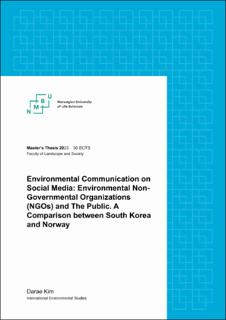| dc.description.abstract | Along with the emphasis on environmental communication, this thesis examines how environmental groups and the public communicate through social media in Norway and South Korea. Environmental communication plays a key role in navigating how we understand the imminent climate change and environmental issues, and achieve a transition to a sustainable future. However, environmental communication is a complex process because it involves various stakeholders and their own interests. Thus, setting appropriate environmental communication is a task that conveys information and encourages various stakeholders to take relevant actions to solve the problem. Specifically, environmental NGOs have been dedicated to serving as intermediaries between the public and other groups including scientists and politicians by bridging each other, who is to be engaged in environmental issues. Meanwhile, the rise of social media use has dramatically transformed the landscape of this environmental communication by fostering abundant networks across different spheres, both environmental groups and the public. Consequently, social media tools are currently used to disseminate environmental advocacy by environmental NGOs (Non-governmental Organizations), as well as to learn about the issues of individuals. Therefore, this thesis presents the interaction between environmental NGOs and public individuals using social media and compares Norwegian and Korean cases. This thesis aims to detect environmental communication gaps among all those distinct spheres, including cultural differences, and provide empirical details capturing valuable implications based on the linked findings.
Accordingly, this thesis is organized as a case study based on in-depth interviews using qualitative research methods. The interviews were conducted with selected environmental NGOs and individuals from Norway and Korea. The NGOs and individual participants were investigated for how NGOs disseminate their agenda using social media, and how individuals perceive environmental information of NGOs and become motivated to take action, respectively. In addition, Agenda-Setting theory and the Theory of Planned Behavior are mainly used to analyze and discuss the findings of results, linking this study to established hypotheses. The discussion focuses on connecting respective findings across the spheres investigated.
The results of this thesis generally confirm the principles of environmental communication, but also identify some gaps in investigated spheres across the levels. The findings show gaps between the communication strategies of NGOs and public perception, individual attitude-behavior gaps, and disparities between Norwegian and Korean groups. These differences encompass framing and perceiving the environmental issue salience, message tones, targeted scale of mitigation efforts, implementation of pro-environmental behaviors, and relationships with relevant stakeholders. This thesis portrays various intersections in the current environmental communication ecosystem and sheds light on the relationship between cultural context and environmental communication. | |
